| Home > Policy > White Paper, Notice, Announcement > White Paper > EDUCATIONAL STANDARDS IN JAPAN 1975 > CHAPTER6 2 | ||
With remarkable economic growth and radical social changes in Japan since the 1960s as background, the Japanese people have become more and more affluent economically and have come to have more and more leisure time.
Changes of economic and social conditions have helped to bring about, in the field of education, an increase in the proportion of students advancing to higher-level schools and a rapid growth of the population educated at institutions of higher educational levels outside school education, the growing demand for various learning, sport and cultural activities.
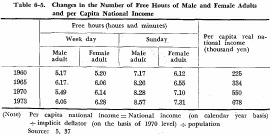
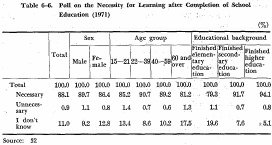
In this connection, the proportion of those who think it necessary to continue some form of learning after finishing school, is shown in Table 6-6. It indicates that as many as 80-90% of those responding realize the need for some form of learning, irrespective of their sex, age and educational background.
Above all, the proportion of those realizing the "need for learning" is higher among those with a higher educational background. It deserves attention since it indicates a rising demand for more diversified learning and cultural activities as more people reach higher levels of education.
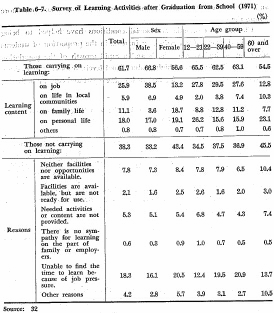
The proportion of people, carrying on learning after graduating from school, as classified by their subject field of study is shown in Table 6-7.
Under such circiumstances, the need to formulate a comprehensive plan for education including school education has been emphasized, as the means of enabling people to deal adequately with various educational problems they face in each cycle of their lives. Recently this concept conceived as so-called lifelong education has become a major problem to be solved in terms of educational philosophy and policy measures. The Central Council for Education suggested, in its recommendation of 1971, that, while in view of the need for comptehehsive review of the whole educational system from the viewpoint of lifelong education, respective roles of school education, home education and social edtcation should be clearly defined, and that these three categories of education should be kept in close mutual cooperation. Also, in the recommendation submitted by the Social Education Council in the same year, the educational problems at each stage of life, ranging from infancy to the period of advanced age, and the roIe of and proper measures to be taken in social education in order to cope with those problems wete set out from the viewpoint of lifekong education.
And, at the Intemational Conference on Adult Education held in Tokyo in 1972 under the sponsorship of Unesco, the importance of adult education in society it the future was emphasized from the viewpoint of lifelong education. Discussion centered on the appropriate measures to be taken.
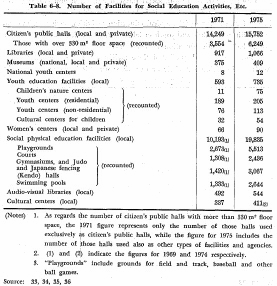
With a view to meeting the growing demand for out-of-school education, as stated above, various sorts of opportunities are being made available in varied fields. In this regard, the number of facilities made avaiable for social education, social physical education and cultural activities is shown in Table 6-8. It indicates a sizeable increase particularly in the facilities for social physical education activities, such as gymnasia, and facilities for adult and youth social education activities, such as citizen's public halls, youth educatjon facilities, etc.
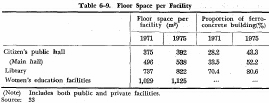
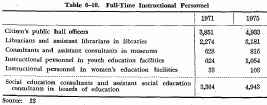
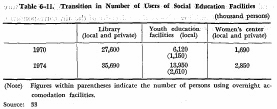
Both the size and quality of these facilities are also being improved. As shown in Table 6-9, their average floor space is in expansion and in regard to their structure, the proportion of "ferro-concrete" facilities is groing steadly.
The number of full-time instruccional personnel in social education facilities, etc. also increased in every field from 1971 through 1975, as shown in Table 6-10.
And the growing trend in utilization of social education facilities in recent years is illustrated, as indicated in Table 6-11, by a remarkable growth in the number of library users, and participants in training and study activities in youth education facilities and women's centers.
Thus it has been shown. that the demand for education has been diversifying and growing in parallel with social changes, and that expansion and improvement of social education facilities as well as physical education and cultural facilities have been under way to respond to such demand.
In view of these circumstances, it is imperative in the future that both the national and local governments further advance policy measures on the systematic improvement and increase of facilities for social education, cultural and sports activities, etc., on training and in-service training of instructors, and on financial assistance to relevant private activities so that the learning opportunities corresponding to educational problems at each stage of life can be enlarged.
Furthermore, in order to respond to the many varied demands for education, it is an important task, in considering the desirable relationship between education and society in the future, to further strengthen the mutual cooperation between social education and other forms of education and study the feasibility of making flexible the whole educational structure including special training schools, the university of the air, correspondence education and so forth.
| Back to Top | MEXT HOME |